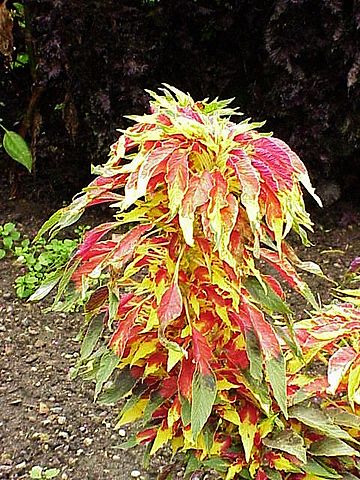Amaranthus tricolor, known as edible amaranth,[3] is a species of flowering plant in the genus Amaranthus, part of the family Amaranthaceae.
| Amaranthus tricolor | |
|---|---|
 | |
| Scientific classification | |
| Kingdom: | Plantae |
| Clade: | Tracheophytes |
| Clade: | Angiosperms |
| Clade: | Eudicots |
| Order: | Caryophyllales |
| Family: | Amaranthaceae |
| Genus: | Amaranthus |
| Species: | A. tricolor |
| Binomial name | |
| Amaranthus tricolor | |
| Synonyms[1] | |
|
List
| |
The plant is often cultivated for ornamental and culinary purposes. It is known as bireum in Korea;[3] tampala, tandaljo, or tandalja bhaji in India;[4] callaloo in the Caribbean; and Joseph's coat in other areas, in reference to the Biblical story of Joseph and the coat of many colors. Although it is native to South and South-East Asia, A. tricolor is one of several species of amaranth cultivated in warm regions across the world.[citation needed] Cultivars have striking yellow, red, and green foliage.
Culinary uses

The leaves and stems may be eaten as a salad vegetable. In Africa, it is usually cooked as a leafy vegetable.[5] It is usually stir fried or steamed as a side dish in both China and Japan.[citation needed]
China
In China, it is referred to as xiàncài (simplified Chinese: 苋菜; traditional Chinese: 莧菜) and is often stir-fried with garlic and salt.[citation needed]
Korea
In Korea, the plant is referred to as bireum (비름). Small-leaved, reddish-stalked chambireum (참비름, "true bireum") is used as a namul vegetable in Korean cuisine. Considered a san-namul (wild green) that grows abundantly in the countryside, it tends to be foraged rather than planted and harvested.[6] It has an earthy and nutty flavor, and goes well with both gochujang- and soup soy sauce-based seasonings, and bori-bap (barley rice).[6][7]
- Bireum-namul (seasoned edible amaranth)
- Amaranth(Edibles) Flower
In culture
It appears on the coat of arms of Gonville and Caius College, Cambridge, where it is called "flowers gentle".[citation needed]
Amaranthus gangeticus
Amaranthus gangeticus is considered a synonym of A. tricolor,[8] but has been recognized as a separate species in the past. A. gangeticus is also known as elephant-head amaranth. It is an annual flowering plant with deep purple flowers. It can grow to 2–3 feet (0.61–0.91 m) tall. In Bangladesh, it has been used as a leafy vegetable. It may inhibit calcium retention in rice-based diets.[9]
References
External links
Wikiwand in your browser!
Seamless Wikipedia browsing. On steroids.
Every time you click a link to Wikipedia, Wiktionary or Wikiquote in your browser's search results, it will show the modern Wikiwand interface.
Wikiwand extension is a five stars, simple, with minimum permission required to keep your browsing private, safe and transparent.


